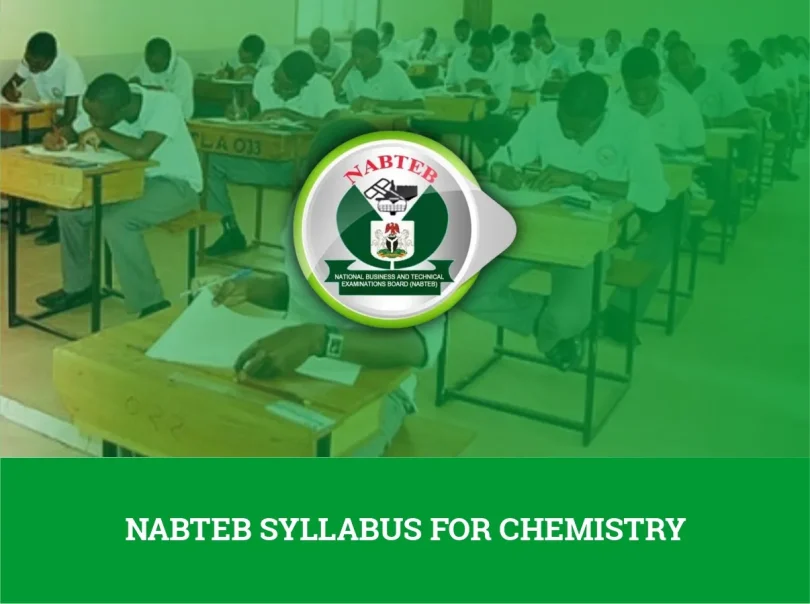The National Business and Technical Examinations Board (NABTEB) has officially released the syllabus for all subjects ahead of the upcoming examination. This syllabus is designed to guide candidates on the areas they are expected to study and prepare for. It has been carefully structured to improve performance by helping students focus on the right topics.
Candidates who take the time to study with the syllabus are usually better prepared and have a greater chance of success. If you are sitting for Chemistry in the next NABTEB examination, having the NABTEB Syllabus for Chemistry is essential.
The NABTEB Chemistry Syllabus outlines all the key topics you’ll be tested on, including what to expect in your practical sessions. Read on to see the complete NABTEB syllabus for Chemistry.
Examination Scheme
The examination is divided into two papers: Paper I and Paper II.
Paper I (Theory): This paper lasts for 2 hours and 30 minutes and carries a total of 150 marks. It is divided into two sections: Part A and Part B.
- Part A contains fifty (50) multiple-choice questions. You will have 50 minutes to complete this section, which is worth 50 marks.
- Part B includes five (5) essay questions, from which you are required to answer only four (4). Each essay question carries 25 marks, making a total of 100 marks. You will have 1 hour and 40 minutes to complete this section.
Paper II (Practical): This paper lasts for 2 hours and is worth 50 marks. It consists of three (3) compulsory questions. The practical test may either be the actual hands-on practical exercise conducted in schools or an alternative to practical designed for private candidates.
- Schools conduct the actual practical examination.
- Private candidates will take the alternative to practical, which assesses your understanding of the practical skills and procedures outlined in the syllabus.
Practical for NABTEB Chemistry
General Skills and Principles
You are expected to be familiar with the following practical skills and principles:
- Measurement of length, mass, and volume.
- Preparation and dilution of standard solutions.
- Filtration, recrystallization, and determination of melting points.
- Measurement of heats of neutralization and solution.
- Determination of pH values of various solutions using colorimetry.
- Determination of reaction rates from concentration versus time curves.
20.2 Quantitative Analysis
You should be skilled in acid-base titrations, including:
Preparation of standard solutions, including primary and secondary standards.
Using standard acid and alkali solutions with indicators such as methyl orange and phenolphthalein to determine:
- The concentration of acid and alkali solutions.
- The molar masses of acids, bases, and water of crystallization.
- The solubility of acids, bases, and salts.
- The percentage purity of acids and bases.
Be able to perform calculations for both direct and back titrations, with answers rounded to 3 significant figures.
20.3 Qualitative Analysis
No formal scheme of analysis is required, but you should be able to:
(a) Tests for Cations
- Perform characteristic tests for the following cations using dilute NaOH and NH₃(aq): NH₄⁺, Ca²⁺, Pb²⁺, Cu²⁺, Fe²⁺, Fe³⁺, Al³⁺, and Zn²⁺
- Carry out confirmatory tests for these cations.
(b) Tests for Anions
Understand the characteristic reactions of dilute HCl on solid samples or aqueous solutions and concentrated H₂SO₄ on solid samples for the following anions:
- Cl⁻, SO₃²⁻, CO₃²⁻, NO₃⁻, SO₄²⁻
Perform confirmatory tests for these anions.
(c) Comparative Study of Halogens
- Observe displacement reactions among halogens.
(d) Tests for Gases
- Identify the following gases through characteristic tests: O₂, H₂, NH₃, CO₂, HCl, SO₂, H₂S
- Note: The use of litmus paper is only acceptable for identifying ammonia gas and not as a confirmatory test for others.
(e) Test Tube Reactions for Functional Groups in Organic Compounds
Perform characteristic reactions for the following compounds:
- Alkenes
- Alkanols
- Alkanoic acids
- Sugars (using Fehling’s and Benedict’s solutions only)
- Starch (iodine test only)
- Proteins (using Ninhydrin test, Xanthoproteic test, Biuret test, and Millon’s test only)
NABTEB Syllabus For Chemistry
| S/N | Topic/Objectives | Contents | Activities/Remarks |
|---|---|---|---|
| 1 | Elements, Compounds and Mixtures | 1.1 Explain concepts of elements, compounds, mixtures. 1.2 Identify properties (melting point, boiling point, solubility) of common substances for separation methods. | – Concepts of Elements, Compounds and Mixtures. – Physical and chemical changes. – Definitions. – Separation methods. – Use burning candle to demonstrate physical and chemical changes. – Experimental illustration of separation methods. |
| 2 | Structure of the Atom | 1.1 Concepts of atoms, molecules, ions. 1.2 Features of the atom. 1.3 Draw & label electronic shells; explain atomic number, isotopes, Ar, Mr. 1.4 Electron arrangement in main & sub-energy levels. 1.5 Explain orbitals and electron filling rules. 1.6 Distinguish chemical and nuclear reactions. 1.7 Explain types of radiation. 1.8 Define radioactivity, natural & artificial. 1.9 Define half-life. 1.10 Write/balance nuclear equations. 1.11 Effects and uses of radioactive radiation. | – Dalton’s atomic theory. – J.J. Thomson’s & Bohr-Rutherford’s experiments. – Atomic number, mass number, isotopes. – Electron shells (K, L, M), orbitals (s, p, d, f). – Aufbau Principle, Hund’s rule, Pauli’s exclusion. – Nuclear chemistry concepts. – Use chlorine isotope calculation as example. – Geiger-Muller counter description. – Highlight nuclear reactions creating new elements. – Symbols for radiation types. |
| 3 | Periodicity of the Element | 1.1 State periodic law and application. 1.2 Outline periodic properties & trends. 1.3 Periodic graduation of halogen properties. 1.4 Explain transition metals and their properties. | – Electronic configuration relating to groups/periods. – Uniqueness of hydrogen. – Periodic properties: atomic size, ionization energy, electron affinity, electronegativity. – Trends in metallic to nonmetallic character. – Halogen properties: physical states, melting points, redox & displacement reactions. – Transition metals: variable oxidation states, magnetic properties, catalysis. – Highlight variable oxidation states in non-metals and constant states in metals like zinc. |
| 4 | Chemical Bonding | 4.1 Explain chemical bonding and types. 4.2 Illustrate ionic bonding with examples; list influencing factors & properties. 4.3 Illustrate covalent & coordinate bonding; factors & properties. 4.4 Draw shapes of simple molecules. 4.5 Explain metallic bonding, influencing factors, and properties. 4.6 Explain Van der Waals forces with examples. 4.7 Explain hydrogen bonding and its effect on boiling points of HF, H2O, NH3. | – Chemical bonding as achieving noble gas structure. – Lewis dot structures for ionic & covalent compounds. – Ionic bonding factors: ionization energy, electron affinity, electronegativity difference. – Covalent bonding factors & molecular shapes (linear, non-linear, tetrahedral). – Metallic bonding: atomic radius, valence electrons, conductivity, malleability. – Intermolecular forces: Van der Waals, dipole-dipole, hydrogen bonding. – Use metal samples like Mg, Zn, Sn, Fe for demonstrations. – Models and molecular shapes for illustration. |
| 5 | Stoichiometry and Chemical Reactions | 5.1 Explain symbols, formulae, equations. 5.2 State laws of chemical combination. 5.3 Explain moles, Avogadro number, mole ratios. 5.4 Explain concept of solutions and concentration. | – Chemical symbols, empirical & molecular formulae. – Balancing chemical equations. – Law of conservation of mass, constant composition, multiple proportions. – Mole concepts: mass, volume, Avogadro constant, mole ratio. – Calculations involving molar concentration. – Preparation of standard solutions (e.g., Na2CO3). – Experimental illustrations of laws. – Concept of solutions: solute, solvent, concentration terms. – Dilution factor calculations. |
| 6 | States of Matter | 1.1 Define law, theory, hypothesis. 1.2 Postulates of kinetic theory. 1.3 Gas laws with mathematical & graphical representation. 1.4 Relationship of vapor pressure with boiling points. 1.5 Classify solids; compare properties & describe structure of diamond and graphite. | – Kinetic theory: solids, liquids, gases. – Changes of state: melting, boiling, diffusion. – Gas laws: Boyle’s, Charles’s, Dalton’s, Graham’s, Avogadro’s laws. – General gas law derivation & calculations. – Vapor pressure and boiling point determination. – Solid types: ionic, metallic, covalent, molecular. – Brownian motion demonstrations. – Experimental boiling point determination. – Structure and uses of diamond & graphite. – Differentiate Dalton’s law from Dalton’s atomic theory. |
| 7 | Energy and Energy Changes | 7.1 Define energy and its forms. 7.2 Explain exothermic/endothermic reactions, heats of reaction, formation, combustion, neutralization, solution. 7.3 Concepts of free energy and entropy. | – Energy changes during physical & chemical processes. – Enthalpy and energy diagrams. – Measurement and calculation of heat changes. – Conservation of energy law. – Applications of energy concept |
Every topic listed is a potential exam question, so don’t leave anything out during your study sessions. To boost your preparation, make use of the right textbooks and go through past questions, and they’ll give you a better feel for the kinds of questions that usually come up.
Stuck on a topic or not sure about something? Feel free to ask in the comments; we’re here to help you get it right. If you know someone else preparing for NABTEB, do them a favour and share this post.







Leave a Comment